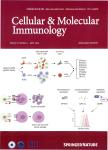Binding of Divalent H-2K^(d)/IgG2aFc Fusion Protein to Murine Macrophage via Fc-FcR Interaction
Binding of Divalent H-2K^d/IgG2aFc Fusion Protein to Murine Macrophage via Fc-FcR Interaction作者机构:Department of Immunology Tongji Medical College Huazhong University of Science & Technology Wuhan 430030 China Department of Immunology School of Medicine Shihezi University Shihezi 832002 China
出 版 物:《Cellular & Molecular Immunology》 (中国免疫学杂志(英文版))
年 卷 期:2007年第4卷第2期
页 面:147-151页
核心收录:
学科分类:1002[医学-临床医学] 1001[医学-基础医学(可授医学、理学学位)] 100102[医学-免疫学] 100214[医学-肿瘤学] 10[医学]
基 金:supported by a grant from the National Natural Science Foundation of China(NO.30271201)
主 题:H-2K^d/IgG2aFc divalent MHC fusion protein Fc receptor
摘 要:Peptide-MHC class I complex (pMHC) is a specific ligand for TCR recognition, and important for CD8^+T cell activation. Here we described a genetically engineered divalent class I major histocompatibility complex (MHC) molecule, H-2K^d/IgG2aFc, a fusion protein consisting of the extracellular domains of H-2K^d, a murine MHC class I molecule, and the Fc region of IgG2a. This fusion protein is expected to attach the H-2K^d molecule to the surface of murine macrophage (MФ) through its Fc portion binding to Fc receptor (FcR) of MФ. cDNAs coding for the extracellular domains of H-2K^d and the Fc region of IgG2a were cloned respectively, and then recombined into plasmid pcDNA3.1(+). The H-2K^d/IgG2aFc protein was expressed by the plasmid-transfected cell line J558L, and purified from its supernatant with a Staphylococcal Protein A (SPA) column. The fusion protein showed a 58.4 kDa band as revealed by SDS-PAGE and Western blotting with murine IgG-specific antibody, which consists with that expected for extracellular domains of H-2K^d heavy chain plus the Fc region of IgG2a. The sandwich ELISA assay with antibodies specific for Fc portion and for H-2K^d indicated the fusion protein consists of both Fc portion and H-2K^d. Peritoneal MФ of C57BL/6 (H-2K^b) can be stained with H-2K^d specific monoclonal antibody (mAb) after incubated with the H-2K^d/IgG2aFc fusion protein. These results demonstrate the fusion protein can be used to attach the H-2K^d molecule to the surface of murine MФ, and provides a novel means to manipulate the T cell recognized epitope on the surface of murine MФ, which can be applied to activate antigen-specific cytotoxic T lymphocyte (CTL).



